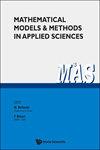变量选择后的无分布自举预测区间
IF 3
1区 数学
Q1 MATHEMATICS, APPLIED
Mathematical Models & Methods in Applied Sciences
Pub Date : 2023-01-01
DOI:10.12988/ams.2023.917388
引用次数: 0
摘要
本文提出了两个新的线性回归模型在变量选择后的预测区间。与大多数现有的预测区间相比,所提出的预测区间的优点之一是不需要知道误差的分布。对所提出的预测区间的渐近常数性也进行了检验,并表明预测是渐近最优的。模拟结果表明,即使对于稀疏模型,新的区间也能产生更好的预测结果。我们将新的预测区间与一些广泛使用的预测区间在覆盖范围和长度方面进行了比较。本文章由计算机程序翻译,如有差异,请以英文原文为准。
Distribution free bootstrap prediction intervals after variable selection
In this paper, we propose two new prediction intervals for linear regression models after variable selection. One of the benefits of the proposed prediction intervals compared to most existing ones is that the distribution of the errors does not need to be known. The asymptotic constancy of the proposed prediction intervals was also examined and showed that the predictions are asymptotically optimal. Simulations were used to illustrate that the new intervals are able to produce better predictions even for sparse models. We compare the new prediction intervals with a few widely used prediction intervals in terms of their achieved coverage and length.
求助全文
通过发布文献求助,成功后即可免费获取论文全文。
去求助
来源期刊
CiteScore
6.30
自引率
17.10%
发文量
61
审稿时长
1 months
期刊介绍:
The purpose of this journal is to provide a medium of exchange for scientists engaged in applied sciences (physics, mathematical physics, natural, and technological sciences) where there exists a non-trivial interplay between mathematics, mathematical modelling of real systems and mathematical and computer methods oriented towards the qualitative and quantitative analysis of real physical systems.
The principal areas of interest of this journal are the following:
1.Mathematical modelling of systems in applied sciences;
2.Mathematical methods for the qualitative and quantitative analysis of models of mathematical physics and technological sciences;
3.Numerical and computer treatment of mathematical models or real systems.
Special attention will be paid to the analysis of nonlinearities and stochastic aspects.
Within the above limitation, scientists in all fields which employ mathematics are encouraged to submit research and review papers to the journal. Both theoretical and applied papers will be considered for publication. High quality, novelty of the content and potential for the applications to modern problems in applied sciences and technology will be the guidelines for the selection of papers to be published in the journal. This journal publishes only articles with original and innovative contents.
Book reviews, announcements and tutorial articles will be featured occasionally.

 求助内容:
求助内容: 应助结果提醒方式:
应助结果提醒方式:


